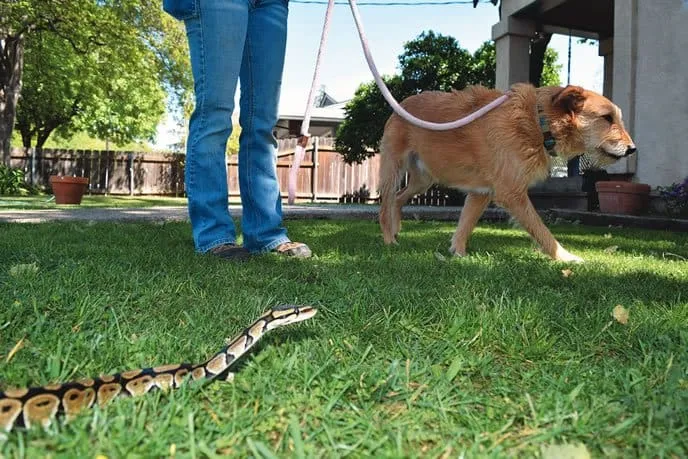Positive training methods focus on rewarding activities, and they’re fun for dogs and handlers. But mention rattlesnakes and many dog owners worry that positive reinforcement isn’t enough. In order to remain safe around rattlesnakes, some say, your dog may need aversion training with an electronic (shock) collar.
In conventional aversion training, dogs receive uncomfortable or painful electric shocks when exposed to whatever their owners want them to avoid. In theory, the dog will associate the sight, smell, or sound of a rattlesnake or other danger with the pain of a shock and immediately run away.
“But that doesn’t always happen,” says Jamie Robinson, founder of Seize the Leash in Tucson, Arizona. “One never knows what the dog is actually associating with the shock when it happens. I know of several dogs here in Tucson who now attack rattlesnakes after ‘snake breaking,’ since snakes were associated in their minds with the pain received during training. That association caused these dogs to attack rather than run in order to avoid the associated pain. Another dog is reportedly terrified of oscillating sprinklers because they sound like a snake’s rattle.”
While the best aversion trainers introduce shock collars gradually and with concern for the dog’s age, size, history, and personality, no one can guarantee that any aversion-trained dog will never be harmed by whatever it was trained to avoid. Accidents happen. In addition, canine responses to snakes vary. Some dogs are naturally cautious and reluctant to explore new situations; others are eager to inspect, smell, and taste the unfamiliar; and some breeds are more likely than others to chase or attack a snake, poisonous toad, or moving object.
Avoid Snakes Using Positive Training!
Is it possible to teach a dog to avoid snakes without using a shock collar? Like Robinson, a growing number of trainers say YES! Their goal is not to produce a dramatic reaction in which the dog recognizes a rattlesnake and runs or jumps in the opposite direction; their goal is for the dog to recognize the snake (or whatever it has learned to avoid) and stay away.
Robinson’s approach, which she calls Structured Game Training, combines play with purpose, cooperation, and goals. “If you really want a dog to stay away from something,” she says, “you have to make it the dog’s choice, not just a conditioned response.”
Her book Snake Avoidance Without Shock provides detailed instructions for playing games lasting five minutes or less, no more than one game per day, for six weeks. Its themes include self-control, motivation, “leave it,” maintaining close proximity to the handler, “stay” (in a variety of positions), developing a reliable recall, distraction training, perfecting an emergency distance sit/stay, drop on recall, odor identification, targeting, “back up, it’s dangerous,” proofing, and more. Some are familiar obedience behaviors and others completely different, but all work systematically to improve dog/handler communication and canine safety.
Does your dog chase after squirrels, rabbits, cats, toxic toads, lizards, porcupines, skunks, cars, or bicycles? Do you live around dangerous plants, like spiny cactus or poisonous mushrooms? Does your dog vacuum the floor, picking up cookie crumbs, ant traps, prescription drugs, or chocolate? Maybe your pup swallows chew toys and underwear. Our dogs risk life and limb every day, even without the threat of poisonous reptiles, and Robinson’s exercises can help any dog avoid all of those problems.
When it’s time to introduce rattlesnakes, she offers step-by-step instructions using fake snakes and the real thing, provided by a local herpetologist.
“The most important part of teaching snake avoidance does not involve humans,” she says. “The dog must learn what to do when confronted with the sight, sound, and/or smell of a snake even when the human is missing. An estimated 85 percent of all snake bites to pets happen in their own backyard. The key to success in this type of training is that it’s inherently easy and fun for both of you. If it isn’t, it will be a source of stress.”
Robinson’s Seize the Leash training center in Tucson offers eight-week Snake Avoidance Without Shock workshops. She will soon offer classes in Clearwater, Florida, where she moved in March.
In California, trainer Pamela Johnson became interested in rattlesnakes when she and her husband moved to a rural area. “In my opinion, teaching dogs to avoid rattlesnakes is the same as teaching them to do tricks or any other behaviors,” she says. “I build a relationship and use management and common sense to keep dogs safe from all dangerous things, not just rattlesnakes.”
Force-free aversion training can be practiced anywhere and at any time. “There isn’t any fall-out or stress when using positive training methods,” she says, “but it is not a quick fix. It requires commitment. For best results, you have to take the time to work with your dog.”
Johnson teaches specific behaviors and skills using games and play. The relationship-building lessons include handler focus and attention, “settle on the go,” body blocking (trained as a behavior and not by using force or intimidation), a variety of emergency collar-grab games, luring, targeting, leash-walking, impulse control, fun recall games, and stay games.
“I teach owners how to train their dogs to do a variety of tricks, agility skills, and canine-freestyle behaviors that are designed to move dogs away from rattlesnakes,” she explains. “My goal is to show others how to have fun with their dogs and at the same time teach their dogs life-saving skills. The main part of my program teaches dogs to recognize snakes, avoid them, and go to their owners. I introduce sight, sound, and scent by using remote-controlled snakes, fake snakes, snake sounds, and dead snakes (snake skin and snake feces).”
Johnson’s Positive Rattlesnake Avoidance webinar is available from the Pet Professional Guild. This July, her Positive Rattlesnake Avoidance Training and Safety Program DVD will be published by Tawzer Dog. “It is a complete guide to training the behaviors and games,” she says, “and gives insight into rattlesnake behavior, teaches simple ways to tell the difference between venomous and non-venomous snakes, answers questions about rattlesnakes, provides helpful tips on safety, and walks you through a variety of ways to make your backyard safe and rattlesnake-free.”
CJ Puotinen, author of The Encyclopedia of Natural Pet Care and other books, is a long-time contributor to WDJ. She lives in Montana.
Related Articles
How to Prevent or Treat Bites from Poisonous Snakes
Are You Sure It Was A Rattlesnake?
Appreciating Rattlesnakes
Why Are The Effects Of Snake Venom So Varied?
A Snake-Bite Survival Story









Any positive snake avoidance done south of Tucson? I have a dog who has a hard time with strangers.
She also has fear aggression around dogs who “ don’t look like her”…
thanks!
Julie
I’m somewhat aghast at the information, or more importantly, the lack thereof, in the writer’s opinion and suggestion of teaching snake avoidance to dogs. How dependable is the method spruiked? Proof provided? Unfortunately, little to none. All that’s at risk is your dog’s life, especially when there are rarely any second chances with snakebite.
In Australia, we have the 10 most venomous and deadly snakes in the world. Every year in Australia, countless dogs, (and many other animals), die an excruciatingly painful death because of snakebite, so teaching your dog to avoid snakes at all costs, and without a second thought, is imperative.
I actually find it quite pathetic that the writer of this article believes that the ethical and fair use of a electronic dog collar (AKA eCollar) is supposedly “painful” and therefore should be avoided in preference to the so-called”kinder method” of positive reinforcement only training. I’d much rather my dog be subjected to a split second of discomfort from his eCollar to remind him that snakes are to be avoided at all costs, than to die an excruciating and agonising death which happens more often than not. It’s incredibly important that a dog avoids a snake 100% of the time, when you’re there and more importantly, when you’re not.
I’d venture to say that positive reinforcement only training (PR+ only) will NOT provide you with that level of assurance, that guarantee of absolute avoidance when you’re not with it.
You only have to see a dog’s shocking death from snakebite ONCE to realise the hell the animal goes through because of a venomous snakebite. I guarantee you’ll never want to watch it again: I know I wouldn’t either.
Some people can’t even afford the cost of veterinary treatment for snakebite, which can easily run into the thousands and thousands of dollars, so the only alternative is that the dog dies in shocking pain and agony instead.
The ethical and fair use of an eCollar, preferably with a professional dog trainer/behaviourist, is far preferable, far more reliable and infinitely less costly than watching your beloved dog writhe in agony because a snake has chosen to end your dog’s life.
What I find to be very telling is that the writer says little to acknowledge the fact that so many dogs have a natural level of prey drive. Many breeds have extremely high prey drive. Invariably, the dog’s immediate reaction on seeing a snake is to inspect and/or attack. How often do you get a second chance with a venomous snake? The fact of the matter is you very rarely do. If you’re willing to risk your dog’s life by using a method of snake avoidance training that may or may not work the very first time because of the high level of your dog’s prey drive, that’s up to you. I’m not prepared to do that. I’d much rather use an eCollar, ethically and fairly, to teach my dog that snakes are out of bounds, 100 out of 100 times, whether or not I’m there at the time.
A snake’s natural defence is to strike and bite, injecting deadly venom. If your dog is in the line of fire, there’s a very good chance it will suffer terribly as a result if you don’t get immediate medical attention and antivenom. If, as its owner, you’re prepared to try positive reinforcement only training to teach your dog absolute and total avoidance at first sight, then go for it. The chances are the dog’s natural prey drive will override that method of avoidance training you’ve chosen to teach it, because prey drive is the dog’s natural instinct. If you truly believe that using PR+ only is your best method of defence/avoidance, especially when there are no second chances, then all power to you.
You don’t have to agree with the use of an eCollar, nor do you have to like it, but please don’t be obtuse. The eCollar is a tried and true method of teaching snake avoidance at all costs. Weigh up the two options. An instantaneous, split second level of discomfort via the use of an eCollar, or the option of a deadly, venomous snakebite? If you teach your dog absolute avoidance via an eCollar, the actual training should take no more than 3 interventions via the eCollar before the dog understands the training. The use of positive reinforcement only training will take how long? How confident can you be that PR+ training will ALWAYS override a dog’s natural instinct/prey drive, especially when you’re not there?
Before anyone totally discounts the use of eCollar training for snake avoidance, take the time to at least learn and understand why you’re choosing to use a specific method. Don’t be so foolish as to denounce a particular method in the absence of knowledge, unless you understand the advantages, benefits and reliability of that specific method, regardless of what that method is.
The questions you should be asking yourself are,
1. What are the benefits and advantages of any specific training methodology, including the level of assurance and reliability in that training?
2. Are there any inherent risks that should be avoided in the use of a specific training method?
and,
3. If my chosen method of teaching guaranteed snake avoidance is the use of PR+ only, just how much confidence do I have in believing that PR+ only training will always, always override my dog’s natural prey drive, especially when I’m not there?
Then, and only then are you in a position to look at the potential success of your choice.
I think the “rationale” here is that you’re stuck in your own methods. As pointed out, force methods can, and often do, have the opposite effect of what is intended. But then, many “trainers” get personal gratification from using force on dogs. I worked in law enforcement and saw that all the time. It becomes such a habit, that some handlers even do it just for fun.
Thank you. It’s hard to figure out people who think that forcing a dog (pulling him on a leash) to approach a snake and then shocking him for it is right or effective. But then, I’ve also witnessed other mindless brutality in “dog training.”